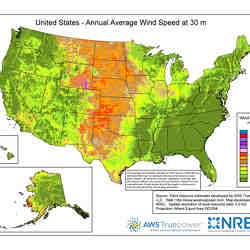
In November, Facebook announced that its newest data center, expected to go online in 2015 in Altoona, Iowa, will be powered completely by renewable wind energy from a 138-megawatt (MW) project being built elsewhere on the Iowa grid. The announcement is yet another sign that high-tech corporations are seriously addressing their environmental impacts.
Yet the renewable energy credits (RECs) that attest to renewability are still an imperfect indicator of a facility’s total effect.
As described by the U.S. Environmental Protection Agency, renewable energy generation simultaneously creates two marketable products: electrical power, and the environmental benefits embodied in RECs (each REC represents renewable generation of a megawatt-hour of electrical energy). Once the electricity enters the grid with electricity generated from coal and other sources, its provenance can no longer be tracked; the RECs can still be sold, for example, to utilities that need to meet state-by-state requirements stipulating that some fraction of their generation be renewable. Private companies can also purchase RECs, either "bundled" with the electricity or not, to burnish their green credentials.
Many companies that operate large data centers, including Google, Microsoft, and Apple, have publicly committed to expanding their use of renewable energy sources and reducing their carbon footprints. These commitments reflect a recognition of the growing fraction of electrical generation used by data centers — already well over 1% of the total in the U.S. Renewable electricity from wind and solar-photoelectric projects can augment improved operating efficiency that can help data centers reduce their fossil-fuel consumption.
Unfortunately, the best sites for wind generation are often not the best sites for data centers; some places are just windier, or sunnier, than others. In addition, the intermittent nature of power generation from the wind and sun does not meet the reliable, round-the-clock demands of the data centers. Thus, in recent years, data center operators have favored buying their electricity from the grid in conjunction with RECs to affirm their green credentials. "This arrangement allows each party to focus on what they do best," explains Facebook data center energy manager Vincent Van Son, since large utilities are better able to mix and match various generation sources to meet demand.
A formal tracking and auditing process is in place to ensure that RECs are only claimed once; for example, for meeting state requirements. On their own, RECs do not guarantee renewable generation would not have occurred even without the purchases, nor do they hold any assurance for further increases in capacity. In a thoughtful white paper describing its own renewable-energy strategy, Google refers to these properties as "additionality," in which investments "actually help to create more renewable power." Assuring such additionality requires significant diligence in evaluating projects, as well as the long-term continuity of companies.
Google advocates the use of power-purchase agreements (PPAs) for wind power, such as the one it entered into in 2010 with NextEra Energy Resources in Iowa, in conjunction with its own data center there. In this arrangement, Google agreed to buy a set amount of renewable energy at a known price over the ensuing 20 years; it "retires" the associated RECs, preventing their re-use, and sells the electricity back to the grid at market prices. Google argues that such a long-term commitment is the best way to ensure continued expansion of renewable generation capacity.
At current prices, Google is paying more for the renewable electricity than it would for generic grid power, but future price increases, which could be accelerated if the U.S. implements a carbon tax or similar charges, could potentially mean that the predictable pricing saves the company money in the long run.
Also in November, Microsoft announced a similar agreement, a 20-year PPA to buy all 110 megawatts of output from a wind facility in Texas.
For its part, Facebook also has evaluated the overall impact of its participation beyond the RECs, according to Van Son. "When we settled on Altoona [Iowa] as the location for our fourth data center, one of the deciding factors was the opportunity to help develop a new wind project in the state." The company worked directly with developer RPM Access, and later transferred the project to the regional utility, MidAmerican Energy (MEC), which will build, own, and operate the wind farm. Van Son expressed confidence that "Facebook’s wind energy needs and the transfer of its development rights to the wind project influenced and expanded the wind energy investment that MEC is making."
Nonetheless, it is clear the rules and procedures governing renewable electricity generation, sale, and use will need to be continually revised so they most effectively address the societal goals of reduced fossil-fuel consumption.
Don Monroe is a science and technology writer based in Murray Hill, NJ.



Join the Discussion (0)
Become a Member or Sign In to Post a Comment